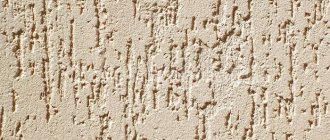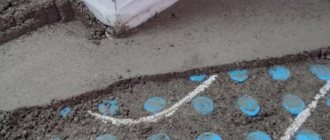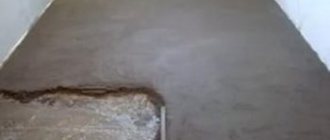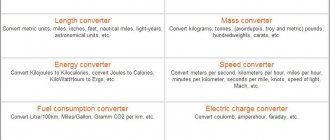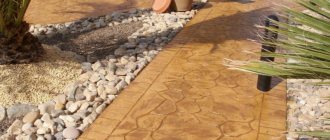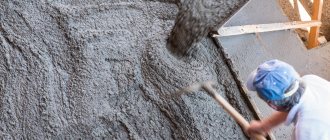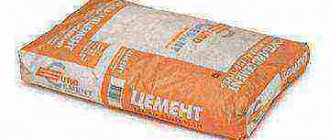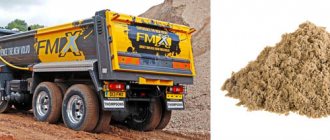- /
- How long does it take for plaster to dry?
According to classification, it is customary to divide plaster into:
- Regular;
- Decorative.
Plaster mixture M150 Rusean
180 ₽.
Product code 182
Plaster is a finishing material that can be used to perform the most.....
Plaster Knauf Rotband 30 kg
370 ₽.
Product code 96
The popular gypsum plaster, manufactured by the German company Knauf, is characterized by excellent adhesion.....
Application area
Knauf mixtures are suitable for all types of finishing work. In the line of this manufacturer you will find ready-made mixtures for work both on internal and external walls, in buildings with low or high humidity, for old walls cracked from years of testing, both manually and machine-applied Rotband gypsum plasters. They are ideally combined with concrete, brick, foam plastic, fiberboard, as well as with already applied mixture! Rotband gypsum plasters are widely used in kitchens and bathrooms. Ideally connected to cleaned concrete walls and ceilings.
The first and most important thing that needs to be done in order for gypsum plaster to lay on the walls as efficiently as possible is to remove all dirt, all kinds of dust and peeling from them. Grind down conspicuous protrusions and metal corrosion protection elements. The application area must be completely dry and able to withstand the weight of the applied gypsum plaster, at a temperature of at least +5 °C.
Material calculation
It is important to understand how many meters of surface you need to process if you want to save your budget and not overpay for material that will then simply be stored in your garage. It is for this purpose that the consumption of gypsum plaster should be calculated.
For correct calculation, it is necessary first of all to take into account the thickness of the required application layer. To find out, craftsmen usually take measurements of irregularities along the entire length and width of the wall surface using special control point indicators. After summing up the resulting sum of deviations, they divide the sum of all points from which measurements were taken, thereby obtaining the average thickness of the required plaster. The number of counter-points plays a significant role; the more, the better the result. As a rule, the manufacturer indicates the required consumption of dry gypsum plaster per 1 sq.m. taking into account one layer of 10 mm, so what follows is nothing complicated, just mathematics. On Rotband bags it is always written what the dry mixture consumption will be per sq.m. - this will be approximately 8.5 kg, then you only need to multiply this value by the total surface area and the average thickness of the required layer. For example, to process a surface of 20 square meters, taking into account the obtained values at counter points: 1.7 cm, 6 cm, 1 cm, we calculate:
| formula | Answer | |
| Wed. application thickness, cm | 0.6 (min. wall height) + 6 + 1 = 7.6 7,6 / 3 = 2,5 | 2,5 |
| Consumption of gypsum plaster Rotband Knauf per 1 sq. m., kg | 8,5 * 2,5 = 19,5 19,5 | 19.5 |
| Volume per wall, kg | 20 * 19,5 = 396 396 | 396 |
| How many bags of dry mix are needed, pieces | 396 / 30 = 14,5 15 | 15 |
| Price of one bag 30 kg, rub. | 355-380 | |
| How much does Rotband gypsum plaster cost in total, rub? | 355 * 15 = 4705 380 * 15 = 4915 | 4705-4915 |
Installation of beacons
Apply the prepared Rotband solution to the treated base approximately every 30 centimeters, followed by pressing in the indicator profiles, and then make sure that they are all in the same plane. The distance between profiles should be no more than 30 cm.
Installation of protective corners
The already mixed solution of Rotband Knauf gypsum plaster must be spread on the inside of the profile, also in long increments of 30 centimeters.
Important! The installation of the profiles must take place in the same plane as the beacon profiles.
Ways to slow down the setting of gypsum
Each product comes with instructions that must be followed. It is under this condition that the manufacturer guarantees the quality of the product. However, “masters” find ways to improve, or adapt “for themselves,” this or that means. Gypsum putty is no exception.
There are several ways to slow down the setting of gypsum:
- Using glue. Wallpaper (CMC) or wood glue is suitable for this purpose.
- Lemon acid. Using a 0.05% solution of this acid can increase the period of use of the plaster by 30 minutes. If the concentration of the solution is increased to 0.1%, the setting will last for 1 hour.
- Sugar. Adding a 6% granulated sugar solution to plaster also helps to increase the hardening period of the putty. However, it should be noted that this method can affect the strength of the product for the worse.
- Lime. This product is a good retarder. In addition, adding slaked lime makes the putty more flexible. This method is often used when using plaster casting.
- Industrial plasticizers . Construction stores also sell ready-made products that can prolong the setting process of gypsum. Each such product is accompanied by instructions, which indicate the ratio of this product and the main composition, as well as the period for extending the setting. Do not forget that it is better to try any of these methods on a small area, so that later you do not have to do all the work all over again.
And yet, it is better to correctly calculate the amount of mixture that the master can use without the use of various types of retarders and prepare the required amount of putty in several steps.
Gypsum as a building material is used in a large number of different construction works, where it plays the role of a special additive that accelerates the hardening process of various types of solutions.
In some cases, alabaster is used in its pure form, for example, when it is necessary to quickly secure a wire in a groove, fix a socket, or other similar work.
The main advantage of the material itself is the speed of its setting, but in some cases this process needs to be slowed down. In this case, various types of retarders of organic or inorganic origin are used, which can be purchased at a hardware store or found in the home kitchen.
Preparation of plaster solution
As for preparing the solution, the dry mixture/water ratio will be 1 to 3 or 1 to 5. This amount will be ideal in order to avoid possible uneven setting of the solution in the future. When you have applied the first layer of plaster, you should not immediately start applying the second; let the previously applied layer dry and when it is completely dry, repeat the procedure.
Important! Avoid dusting the ground surface.
Before cooking, it is advisable to get a plastic tank already filled with about 18 liters of water filtered from dirt (if it is dirty). Taking into account the proportions, pour in five to seven trowels of plaster and mix. After the solution begins to change its consistency, add the entire mass from the bag and mix with a plaster mixer until you get a homogeneous mass without lumps. Let the resulting solution sit for about five minutes, and then stir again to make sure there are no defects in the mixture. If you notice that the mixture is too thick, add some water.
Attention! Do not try to add water while applying the mixture to the walls - this will only be a disadvantage!
Also, you should not experiment and add other components to the solution; in most cases, this will only cause harm.
How to speed up the drying process of the finish?
Very often, beginners begin to putty the surface even before the previous material has completely dried. Such haste leads to irreparable consequences. To avoid such mistakes, you need to correctly calculate the drying time, which is influenced by the following factors:
- the thickness of the applied coating should be about 1.5 cm, but thus not exceed 5 cm. Three days will be enough for such a surface to dry;
- the required time for complete drying of the walls can be reduced to 1-2 days, but with strict adherence to temperature and air humidity;
- You can proceed with further finishing of the walls only if the mass humidity in the layer of plaster does not exceed 8%;
- it is necessary to “knead” the solution correctly and apply it to a less damp surface.
Sometimes there are situations in which it is really necessary to speed up the drying of the plaster mixture. Of course, it’s better not to disrupt this process, but if you really need it, you can use these tricks:
- if possible, reschedule plastering work for the warmer months;
- the room should be heated with “dry” heat (electric heaters are perfect for this, but use this option with caution to avoid cracks in the walls);
- use a plaster mixture that contains gypsum (this material has a “porous” structure that allows air to pass through well and naturally speeds up the drying process);
- provide a good exchange of fresh air.
Gypsum plaster Rotband. Application
Approximately 25 minutes after the solution has assumed a homogeneous mass, it should begin to be applied to the surfaces to be treated; the layer thickness should be from five to fifty millimeters. As for the application process, for the ceiling, you should apply gypsum plaster with a special plaster falcon, moving towards yourself. For walls, it is also necessary to spread the plaster with a “falcon” up/down or using a trowel. After this, you should level out the entire applied mass using zigzag movements.
In the case when it is necessary to apply a large layer of plaster, you should first apply the first layer of the permissible thickness and only when it is completely dry, continue applying the next one until you get the thickness you need. As a rule, this is not required for ceilings; a maximum of one layer of gypsum plaster is enough.
Venetian
Venetian plaster is a building mixture that has been in great demand for a long time. These products contain components such as precious stones crushed into dust, a dye and a binder. The last ingredient is acrylic.
The main advantages of the presented product include:
- high vapor permeability;
- hardness;
- durability.
It becomes clear whether decorative plaster can be applied to drywall.
Thanks to Venetian plaster, it is possible to protect the surface from fungus and mold. In addition, such a surface does not lose its color when exposed to the sun’s rays and has no odor. The plaster must be applied in a layer 3-5 mm thick. It will take 1-3 days for the material to dry.
Smoothing the surface
When the gypsum plaster has already visually set, thereby visually beginning to acquire a matte tint, it should be smoothed out with a large spatula, making wide longitudinal movements. After this, you can safely glue wallpaper to the surface. If you want to achieve glossiness from the applied Rotband plaster, then you need to do the following: 2.5 - 3 hours after applying the plaster to the surface, apply a moisturizing layer of water, then smooth the applied mass again using a metal grater.
Structuring the surface
Professionals know about this, but you may not have heard yet that the applied Rotband gypsum plaster does not have to be left in the perfectly uniform and smooth form in which you applied it. Many people like to give the applied mass various shapes and even designs!
All you need to do for this is to roll a handy textured roller over the mass that has not yet completely hardened, or use a creative approach and draw a wide variety of designs using the tools available to you.
Small tricks
If you want to get the desired result in the shortest possible time, then in order for the plaster to dry quickly, we advise you to ensure high ventilation of the premises. In the case of using decorative variations of plasters, the application area should be pre-coated with a primer.
Probably the main question that torments everyone after application is how long does it take for Rotband gypsum plaster to dry? Let us answer right away that the complete drying time is usually about 7 days, depending on external conditions.
Also, do not use already contaminated containers and devices for applying plaster several times. All this will only shorten the “life” of the plaster mass, so try to wash your tools with water after each layer of plaster.
Types of plaster mixtures
Basic mortars for plaster have a cement, lime or gypsum base:
- The usual mixture is a cement-sand mortar. This material is used to decorate walls in non-residential and utility rooms. When using a cement composition, the approximate drying time is determined from the calculation: a finishing thickness of 10 mm gains strength after 10 days.
- Cement-lime mortars are used for finishing residential and public buildings. Walls covered with lime plaster improve the thermal insulation of the room. Solutions of this composition are called traditional because they are especially popular among builders. The great demand for this type of material is explained by its low cost and good performance characteristics. This type of solution is used to cover vertical fences that are subject to puttying inside buildings. To lay the 2nd layer of finishing, it is enough to allow the 1st layer of plaster to dry for about 7 hours.
- Solutions containing gypsum added to cement are used for plastering exclusively inside buildings. The use of gypsum plaster can significantly reduce the drying time of walls, especially before laying tiles. Gypsum compositions are prepared for the manufacture of decorative coatings. Various dyes are added to them, thereby achieving the formation of a decorative coating of vertical planes in the home.
If the solution is applied to a concrete base, the final hardening of the finish will occur in 28-30 days.
Video about drying conditions for gypsum plaster:

